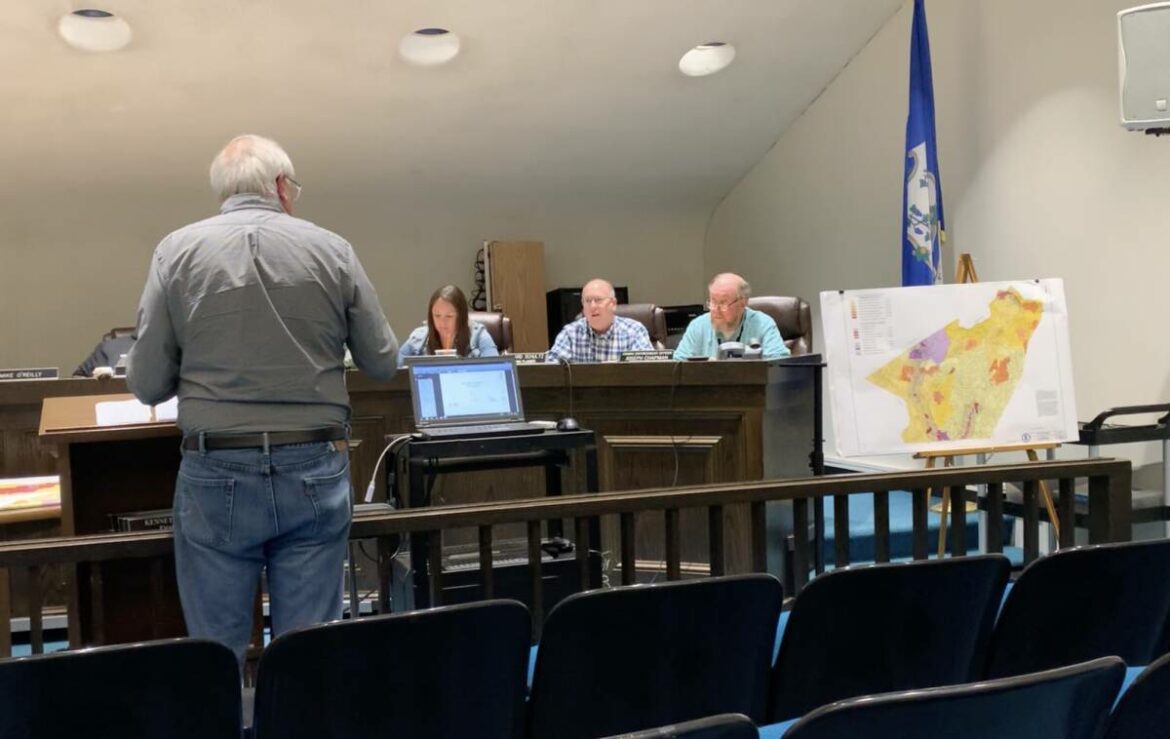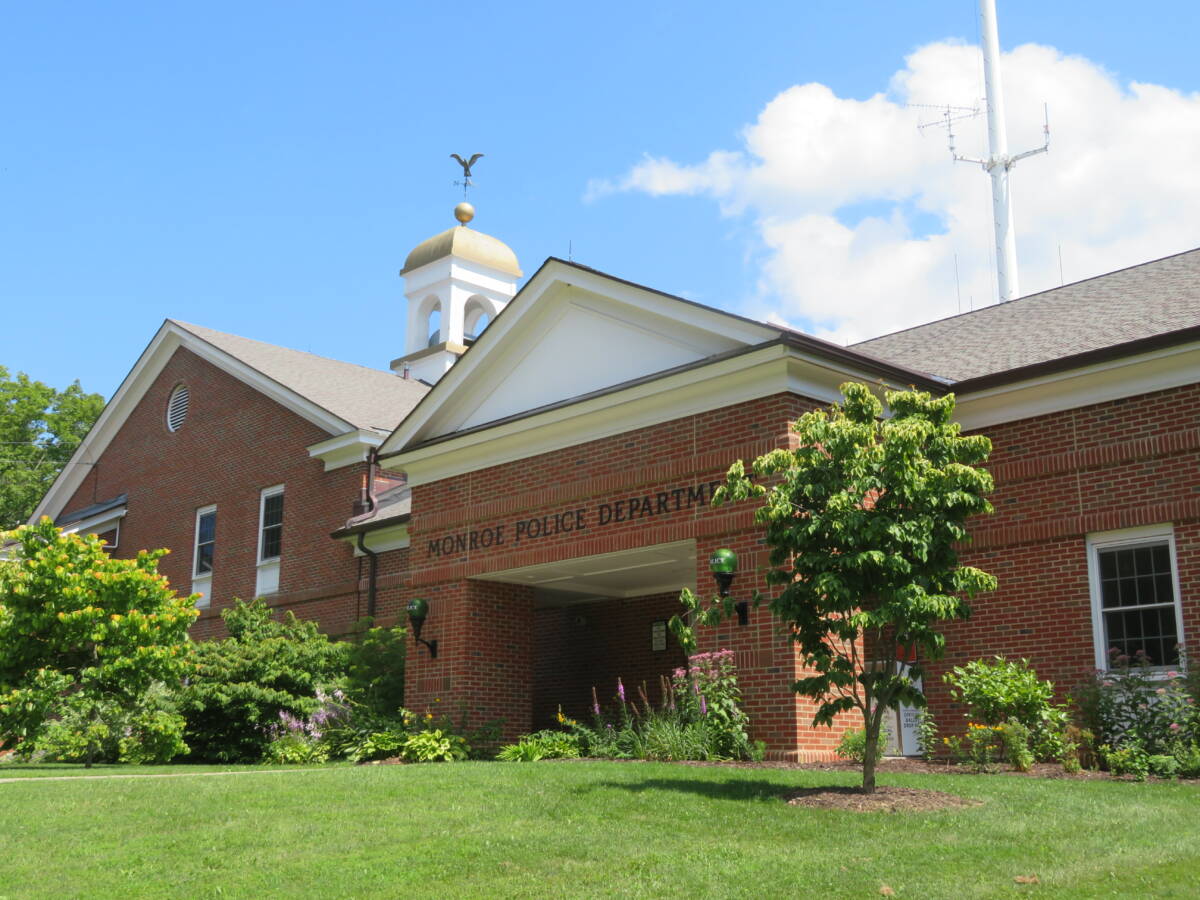MONROE, CT — Planning and Zoning Commission members unanimously approved the town’s first Affordable Housing Plan, following a hearing Thursday.
The Connecticut General Assembly adopted Public Act 17-170 in 2017, requiring every municipality to write a plan explaining how it intends to increase its number of affordable housing developments. The plan must be updated every five years.
The Monroe Planning and Zoning Commission created a Main Street Design District, allowing overlay zones to be applied for to build apartments on properties along Main Street, Monroe Turnpike and Route 34.
Town Planner Rick Schultz said working with developers who apply for special design districts is the best way for the town to control the location, design and density of affordable housing developments.
Otherwise, a developer can come in with an application under 8-30g, Connecticut’s affordable housing statute, which says a town can only deny an application if the commission determines it poses a threat to public health and safety — which is often difficult to prove in court.
“We want to avoid the straight forward 8-30g, because you have no control over the results,” Schultz said.
Of Monroe’s nearly 7,000 housing units, 92 or 1.33 percent meets the state definition of affordable housing. The state’s goal is that 10 percent of every municipality’s housing be affordable.
“We need 599 units to comply with the 10 percent set aside,” Schultz said during a presentation. “I’m not getting into whether it’s realistic to reach. Multiple attempts to change the number failed.”
Schultz said the state expects to see some progress, which he believes Monroe’s plan will achieve. He said the plan will be used as a guide when the commission receives affordable housing applications.
One challenge of increasing the percentage of affordable housing units townwide, is that only 10 percent of units must meet the definition for a housing development to be considered affordable, meaning the remaining 90 percent of units are market rate.
Furthermore, the affordable housing units are deed restricted, and can be sold at market rates within 30 years, effectively losing the affordable status.
What is affordable housing?
“Affordable housing is generally defined as housing that is available to households making less than the area median income and costing less than 30 percent of a household’s annual income,” according to the affordable housing plan.
“This can include both naturally occurring market-rate apartment units or specifically restricted properties that have been income-limited by deed,” it says.
The area median income goes by county rather than by town. The median household income for a family of four in Fairfield County is $98,000, based on the Department of Housing and Urban Development’s 2020 income data.
The affordable housing cost for 80 percent of the area median income is currently $23,520 per year or $1,960 per month.
Chairman Michael O’Reilly said this is not cheap, Section 8 housing. He said it is housing that is affordable for teachers, nurses and other professionals.
“You or your neighbor may qualify, so we’re not talking about low income housing by any stretch of the imagination,” he said.
Among the measures in the Affordable Housing Plan, Monroe will seek to increase affordable housing by increasing awareness of federal type loans (senior housing).
Three locations identified
The Monroe Affordable Housing Plan identified three specific locations for affordable housing:
- Mitchell DeEsso received approval of a conceptual plan to build a mixed-use retail development with up to 50 apartments on the Monroe-Trumbull town line. Two of the 20 apartment units in Monroe would be defined as affordable.
- The Pond View property at 127 Main St. was rezoned to a Special Design District and a conceptual plan was recently approved for 196 multifamily units, 20 of which would be affordable. The developer recently agreed to include elevators in the buildings, which was a concern of commissioners.
- Connecticut Housing Partners received approval to build 49-units of affordable housing for residents age 62-and-older near the former Skate Time property on Main Street. This is a 100 percent affordable development with financing.
In a letter to the commission, George W. Ganim Sr., who owns commercial property on Main Street, praised the effort to have an affordable housing plan and asked that his property at 605 Main St. be included as a potential site for affordable housing.
The owner of 232 Elm St. wants to do an 8-30g development and asked the commission’s subcommittee to consider his property too, according to Schultz.
A draft of the plan also considered a portion of the former Stevenson Lumber site and properties on Route 34 as potential sites.
However, during deliberations Thursday, Commissioner Leon Ambrosey said he would rather the plan be general than specifically identify potential places on the map. Other commissioners agreed, so the plan only includes the three specific places.
Public hearing
Cathy Lindstrom, a resident who serves on the Architectural Review Board, asked if wetlands could cause environmental concerns on some properties whose owners pursue affordable housing developments.
Schultz said a court upheld the denial of an affordable housing application in North Branford, when he was the town planner there, because the property was all wetlands, so it is a valid reason for denial.
However, he said North Branford lost five appeals of its denials in court after that, illustrating how difficult it is for a town to deny an application under 8-30g.
Schultz said all potential sites in Monroe would require soil testing to determine whether it is adequate for septic.
Schultz said Monroe does not have public sewers, limiting the number of affordable housing applications it will have, while other places like Trumbull have been besieged by applications.
If Monroe had a public sewer line, Schultz said the affordable housing applications here could quadruple.
Sandra Alford of Birchwood Road asked about the possibility of someone buying an affordable housing unit and having significantly more occupants than bedrooms.
While it is not always easy to enforce, Ambrosey said Continental Properties, which develops and manages upscale apartment communities and would build the Pond View community, performs inspections and evicts violators who have more occupants than they should, so enforcement does happen.
‘Not even close’
Joel Leneker, a Stepney resident, asked how close Monroe would get to 10 percent if all seven sites initially identified as being eligible for affordable housing were to be developed.
“Not even close,” Schultz said.
Leneker suggested allowing people to have affordable dwellings on their properties to put a dent in the affordable housing deficit.
He also asked what will happen if a developer whose property is not mentioned in the plan approaches the town to build affordable housing.
Schultz said land use staff will inform commissioners of interest from property owners and the subcommittee will determine which properties are reasonable. Then the full commission will decide whether to have a public hearing and update the plan, “because it should be in this plan first, before you go to the zone change.”
Leneker said he believes the affordable housing plan is an opportunity to demand “really good streetscaping and lighting” as properties are developed. “Good design is good business,” he said.
In response to one resident’s question, O’Reilly said the affordable housing plan will be used as a guide and will not allow a developer to build affordable housing as of right.
“I’d like to support an affordable housing plan in Monroe,” Lindstrom said. “This is not only important, but it’s necessary. I think you guys will hopefully use your best judgement, so I support it.”







FWIW
An “affordable housing development” for the purposes of Connecticut General Statutes 8-30g is one that constitutes either “assisted housing” or a “set-aside development”. Assisted housing atypical. The type of development usually proposed by developers is a set-aside development. The definitions of each are reprinted below. Contrary to the article, though:
1. The percentage of units in an 8-30g affordable housing development that must be deed restricted based on the income of their occupants is 30%, not 10%; and
2. The length of time of the deed restriction is forty years, not thirty.
3. The income restrictions are that are that at least 15% of the units must be restricted to families in occupancy making not more than 60% of the area median income, and at least 15% of the additional units must be restricted to families making not more that 80% of the area median income.
4. The income restriction must also provide that the sales or rental prices must be such that housing costs do not exceed 30% of the family in occupancy’s income.
5. The income restrictions apply as of the time of initial occupancy.
Per 8-30g(3):
“‘Assisted housing’ means housing which is receiving, or will receive, financial assistance under any governmental program for the construction or substantial rehabilitation of low and moderate income housing, and any housing occupied by persons receiving rental assistance under chapter 319uu or Section 1437f of Title 42 of the United States Code”; and
Per 8-30g(6):
“‘Set-aside development’ means a development in which not less than thirty per cent of the dwelling units will be conveyed by deeds containing covenants or restrictions which shall require that, for at least forty years after the initial occupation of the proposed development, such dwelling units shall be sold or rented at, or below, prices which will preserve the units as housing for which persons and families pay thirty per cent or less of their annual income, where such income is less than or equal to eighty per cent of the median income. In a set-aside development, of the dwelling units conveyed by deeds containing covenants or restrictions, a number of dwelling units equal to not less than fifteen per cent of all dwelling units in the development shall be sold or rented to persons and families whose income is less than or equal to sixty per cent of the median income and the remainder of the dwelling units conveyed by deeds containing covenants or restrictions shall be sold or rented to persons and families whose income is less than or equal to eighty per cent of the median income”.
Hi Paul, I just checked with land use and it is 10 percent of units now. I don’t know if it used to be 30 percent, because that does sound awfully familiar!
Hi Bill
My cites to the statutory subsections should have been to 8-30g(a)3 and (6).
What you may have been referring to is subsection (k), where the special burden placed on a municipality to justify a denial of an affordable housing application is not applicable to a municipality having 10% of the housing units restricted as provided in that section. For an zoning applicant to take advantage of the special burden of proof placed on the planning and zoning commission, however, a “set-aside affordable housing development” must meet the definition in 8-30g(a)(6).
Another thing is that the applicable median income is the lesser of the state median or the median for the area in which the municipality is located, as determined by HUD. Monroe may be in the Bridgeport Metro Area. The applicable median income is also adjusted for family size.
The housing cost calculations are in regulations promulgated by the CT Commissioner of Housing.
Here is a copy of the statute effective as of October 1, 2022. The definition of a set-aside housing development is unchanged from the present version of the statute.
8-30g
(a) As used in this section and section 8-30j:
(1) “Affordable housing development” means a proposed housing development which is (A) assisted housing, or (B) a set-aside development;
(2) “Affordable housing application” means any application made to a commission in connection with an affordable housing development by a person who proposes to develop such affordable housing;
(3) “Assisted housing” means housing which is receiving, or will receive, financial assistance under any governmental program for the construction or substantial rehabilitation of low and moderate income housing, and any housing occupied by persons receiving rental assistance under chapter 319uu or Section 1437f of Title 42 of the United States Code;
(4) “Commission” means a zoning commission, planning commission, planning and zoning commission, zoning board of appeals or municipal agency exercising zoning or planning authority;
(5) “Municipality” means any town, city or borough, whether consolidated or unconsolidated;
(6) “Set-aside development” means a development in which not less than thirty per cent of the dwelling units will be conveyed by deeds containing covenants or restrictions which shall require that, for at least forty years after the initial occupation of the proposed development, such dwelling units shall be sold or rented at, or below, prices which will preserve the units as housing for which persons and families pay thirty per cent or less of their annual income, where such income is less than or equal to eighty per cent of the median income. In a set-aside development, of the dwelling units conveyed by deeds containing covenants or restrictions, a number of dwelling units equal to not less than fifteen per cent of all dwelling units in the development shall be sold or rented to persons and families whose income is less than or equal to sixty per cent of the median income and the remainder of the dwelling units conveyed by deeds containing covenants or restrictions shall be sold or rented to persons and families whose income is less than or equal to eighty per cent of the median income;
(7) “Median income” means, after adjustments for family size, the lesser of the state median income or the area median income for the area in which the municipality containing the affordable housing development is located, as determined by the United States Department of Housing and Urban Development; and
(8) “Commissioner” means the Commissioner of Housing.
(b)
(1) Any person filing an affordable housing application with a commission shall submit, as part of the application, an affordability plan which shall include at least the following: (A) Designation of the person, entity or agency that will be responsible for the duration of any affordability restrictions, for the administration of the affordability plan and its compliance with the income limits and sale price or rental restrictions of this chapter; (B) an affirmative fair housing marketing plan governing the sale or rental of all dwelling units; (C) a sample calculation of the maximum sales prices or rents of the intended affordable dwelling units; (D) a description of the projected sequence in which, within a set-aside development, the affordable dwelling units will be built and offered for occupancy and the general location of such units within the proposed development; and (E) draft zoning regulations, conditions of approvals, deeds, restrictive covenants or lease provisions that will govern the affordable dwelling units.
(2) The commissioner shall, within available appropriations, adopt regulations pursuant to chapter 54 regarding the affordability plan. Such regulations may include additional criteria for preparing an affordability plan and shall include: (A) A formula for determining rent levels and sale prices, including establishing maximum allowable down payments to be used in the calculation of maximum allowable sales prices; (B) a clarification of the costs that are to be included when calculating maximum allowed rents and sale prices; (C) a clarification as to how family size and bedroom counts are to be equated in establishing maximum rental and sale prices for the affordable units; and (D) a listing of the considerations to be included in the computation of income under this section.
(c) Any commission, by regulation, may require that an affordable housing application seeking a change of zone include the submission of a conceptual site plan describing the proposed development’s total number of residential units and their arrangement on the property and the proposed development’s roads and traffic circulation, sewage disposal and water supply.
(d) For any affordable dwelling unit that is rented as part of a set-aside development, if the maximum monthly housing cost, as calculated in accordance with subdivision (6) of subsection (a) of this section, would exceed one hundred per cent of the Section 8 fair market rent as determined by the United States Department of Housing and Urban Development, in the case of units set aside for persons and families whose income is less than or equal to sixty per cent of the median income, then such maximum monthly housing cost shall not exceed one hundred per cent of said Section 8 fair market rent. If the maximum monthly housing cost, as calculated in accordance with subdivision (6) of subsection (a) of this section, would exceed one hundred twenty per cent of the Section 8 fair market rent, as determined by the United States Department of Housing and Urban Development, in the case of units set aside for persons and families whose income is less than or equal to eighty per cent of the median income, then such maximum monthly housing cost shall not exceed one hundred twenty per cent of such Section 8 fair market rent.
(e) For any affordable dwelling unit that is rented in order to comply with the requirements of a set-aside development, no person shall impose on a prospective tenant who is receiving governmental rental assistance a maximum percentage-of-income-for-housing requirement that is more restrictive than the requirement, if any, imposed by such governmental assistance program.
(f) Except as provided in subsections (k) and (l) of this section, any person whose affordable housing application is denied, or is approved with restrictions which have a substantial adverse impact on the viability of the affordable housing development or the degree of affordability of the affordable dwelling units in a set-aside development, may appeal such decision pursuant to the procedures of this section. Such appeal shall be filed within the time period for filing appeals as set forth in section 8-8, 8-9, 8-28 or 8-30a, as applicable, and shall be made returnable to the superior court for the judicial district where the real property which is the subject of the application is located. Affordable housing appeals, including pretrial motions, shall be heard by a judge assigned by the Chief Court Administrator to hear such appeals. To the extent practicable, efforts shall be made to assign such cases to a small number of judges, sitting in geographically diverse parts of the state, so that a consistent body of expertise can be developed. Unless otherwise ordered by the Chief Court Administrator, such appeals, including pretrial motions, shall be heard by such assigned judges in the judicial district in which such judge is sitting. Appeals taken pursuant to this subsection shall be privileged cases to be heard by the court as soon after the return day as is practicable. Except as otherwise provided in this section, appeals involving an affordable housing application shall proceed in conformance with the provisions of section 8-8, 8-9, 8-28 or 8-30a, as applicable.
(g) Upon an appeal taken under subsection (f) of this section, the burden shall be on the commission to prove, based upon the evidence in the record compiled before such commission, that the decision from which such appeal is taken and the reasons cited for such decision are supported by sufficient evidence in the record. The commission shall also have the burden to prove, based upon the evidence in the record compiled before such commission, that (1) (A) the decision is necessary to protect substantial public interests in health, safety or other matters which the commission may legally consider; (B) such public interests clearly outweigh the need for affordable housing; and (C) such public interests cannot be protected by reasonable changes to the affordable housing development, or (2) (A) the application which was the subject of the decision from which such appeal was taken would locate affordable housing in an area which is zoned for industrial use and which does not permit residential uses; and (B) the development is not assisted housing. If the commission does not satisfy its burden of proof under this subsection, the court shall wholly or partly revise, modify, remand or reverse the decision from which the appeal was taken in a manner consistent with the evidence in the record before it.
(h) Following a decision by a commission to reject an affordable housing application or to approve an application with restrictions which have a substantial adverse impact on the viability of the affordable housing development or the degree of affordability of the affordable dwelling units, the applicant may, within the period for filing an appeal of such decision, submit to the commission a proposed modification of its proposal responding to some or all of the objections or restrictions articulated by the commission, which shall be treated as an amendment to the original proposal. The day of receipt of such a modification shall be determined in the same manner as the day of receipt is determined for an original application. The filing of such a proposed modification shall stay the period for filing an appeal from the decision of the commission on the original application. The commission shall hold a public hearing on the proposed modification if it held a public hearing on the original application and may hold a public hearing on the proposed modification if it did not hold a public hearing on the original application. The commission shall render a decision on the proposed modification not later than sixty-five days after the receipt of such proposed modification, provided, if, in connection with a modification submitted under this subsection, the applicant applies for a permit for an activity regulated pursuant to sections 22a-36 to 22a-45, inclusive, and the time for a decision by the commission on such modification under this subsection would lapse prior to the thirty-fifth day after a decision by an inland wetlands and watercourses agency, the time period for decision by the commission on the modification under this subsection shall be extended to thirty-five days after the decision of such agency. The commission shall issue notice of its decision as provided by law. Failure of the commission to render a decision within said sixty-five days or subsequent extension period permitted by this subsection shall constitute a rejection of the proposed modification. Within the time period for filing an appeal on the proposed modification as set forth in section 8-8, 8-9, 8-28 or 8-30a, as applicable, the applicant may appeal the commission’s decision on the original application and the proposed modification in the manner set forth in this section. Nothing in this subsection shall be construed to limit the right of an applicant to appeal the original decision of the commission in the manner set forth in this section without submitting a proposed modification or to limit the issues which may be raised in any appeal under this section.
(i) Nothing in this section shall be deemed to preclude any right of appeal under the provisions of section 8-8, 8-9, 8-28 or 8-30a.
(j) A commission or its designated authority shall have, with respect to compliance of an affordable housing development with the provisions of this chapter, the same powers and remedies provided to commissions by section 8-12.
(k) The affordable housing appeals procedure established under this section shall not be available if the real property which is the subject of the application is located in a municipality in which at least ten per cent of all dwelling units in the municipality are (1) assisted housing, (2) currently financed by Connecticut Housing Finance Authority mortgages, (3) subject to binding recorded deeds containing covenants or restrictions which require that such dwelling units be sold or rented at, or below, prices which will preserve the units as housing for which persons and families pay thirty per cent or less of income, where such income is less than or equal to eighty per cent of the median income, (4) mobile manufactured homes located in mobile manufactured home parks or legally approved accessory apartments, which homes or apartments are subject to binding recorded deeds containing covenants or restrictions which require that such dwelling units be sold or rented at, or below, prices which will preserve the units as housing for which, for a period of not less than ten years, persons and families pay thirty per cent or less of income, where such income is less than or equal to eighty per cent of the median income, or (5) mobile manufactured homes located in resident-owned mobile manufactured home parks. For the purposes of calculating the total number of dwelling units in a municipality, accessory apartments built or permitted after January 1, 2022, but that are not described in subdivision (4) of this subsection, shall not be counted toward such total number. The municipalities meeting the criteria set forth in this subsection shall be listed in the report submitted under section 8-37qqq. As used in this subsection, “accessory apartment” has the same meaning as provided in section 8-1a, and “resident-owned mobile manufactured home park” means a mobile manufactured home park consisting of mobile manufactured homes located on land that is deed restricted, and, at the time of issuance of a loan for the purchase of such land, such loan required seventy-five per cent of the units to be leased to persons with incomes equal to or less than eighty per cent of the median income, and either (A) forty per cent of said seventy-five per cent to be leased to persons with incomes equal to or less than sixty per cent of the median income, or (B) twenty per cent of said seventy-five per cent to be leased to persons with incomes equal to or less than fifty per cent of the median income.
(l)
(1) Except as provided in subdivision (2) of this subsection, the affordable housing appeals procedure established under this section shall not be applicable to an affordable housing application filed with a commission during a moratorium, which shall commence after (A) a certification of affordable housing project completion issued by the commissioner is published in the Connecticut Law Journal, or (B) notice of a provisional approval is published pursuant to subdivision (4) of this subsection. Any such moratorium shall be for a period of four years, except that for any municipality that has (i) twenty thousand or more dwelling units, as reported in the most recent United States decennial census, and (ii) previously qualified for a moratorium in accordance with this section, any subsequent moratorium shall be for a period of five years. Any moratorium that is in effect on October 1, 2002, is extended by one year.
(2) Such moratorium shall not apply to (A) affordable housing applications for assisted housing in which ninety-five per cent of the dwelling units are restricted to persons and families whose income is less than or equal to sixty per cent of the median income, (B) other affordable housing applications for assisted housing containing forty or fewer dwelling units, or (C) affordable housing applications which were filed with a commission pursuant to this section prior to the date upon which the moratorium takes effect.
(3) Eligible units completed after a moratorium has begun may be counted toward establishing eligibility for a subsequent moratorium.
(4)
(A) The commissioner shall issue a certificate of affordable housing project completion for the purposes of this subsection upon finding that there has been completed within the municipality one or more affordable housing developments which create housing unit-equivalent points equal to (i) the greater of two per cent of all dwelling units in the municipality, as reported in the most recent United States decennial census, or fifty housing unit-equivalent points, or (ii) for any municipality that has (I) adopted an affordable housing plan in accordance with section 8-30j, (II) twenty thousand or more dwelling units, as reported in the most recent United States decennial census, and (III) previously qualified for a moratorium in accordance with this section, one and one-half per cent of all dwelling units in the municipality, as reported in the most recent United States decennial census.
(B) A municipality may apply for a certificate of affordable housing project completion pursuant to this subsection by applying in writing to the commissioner, and including documentation showing that the municipality has accumulated the required number of points within the applicable time period. Such documentation shall include the location of each dwelling unit being counted, the number of points each dwelling unit has been assigned, and the reason, pursuant to this subsection, for assigning such points to such dwelling unit. Upon receipt of such application, the commissioner shall promptly cause a notice of the filing of the application to be published in the Connecticut Law Journal, stating that public comment on such application shall be accepted by the commissioner for a period of thirty days after the publication of such notice. Not later than ninety days after the receipt of such application, the commissioner shall either approve or reject such application. Such approval or rejection shall be accompanied by a written statement of the reasons for approval or rejection, pursuant to the provisions of this subsection. If the application is approved, the commissioner shall promptly cause a certificate of affordable housing project completion to be published in the Connecticut Law Journal. If the commissioner fails to either approve or reject the application within such ninety-day period, such application shall be deemed provisionally approved, and the municipality may cause notice of such provisional approval to be published in a conspicuous manner in a daily newspaper having general circulation in the municipality, in which case, such moratorium shall take effect upon such publication. The municipality shall send a copy of such notice to the commissioner. Such provisional approval shall remain in effect unless the commissioner subsequently acts upon and rejects the application, in which case the moratorium shall terminate upon notice to the municipality by the commissioner.
(5) For the purposes of this subsection, “elderly units” are dwelling units whose occupancy is restricted by age, “family units” are dwelling units whose occupancy is not restricted by age, and “resident-owned mobile manufactured home park” has the same meaning as provided in subsection (k) of this section.
(6) For the purposes of this subsection, housing unit-equivalent points shall be determined by the commissioner as follows: (A) No points shall be awarded for a unit unless its occupancy is restricted to persons and families whose income is equal to or less than eighty per cent of the median income, except that unrestricted units in a set-aside development shall be awarded one-fourth point each. (B) Family units restricted to persons and families whose income is equal to or less than eighty per cent of the median income shall be awarded one point if an ownership unit and one and one-half points if a rental unit. (C) Family units restricted to persons and families whose income is equal to or less than sixty per cent of the median income shall be awarded one and one-half points if an ownership unit and two points if a rental unit. (D) Family units restricted to persons and families whose income is equal to or less than forty per cent of the median income shall be awarded two points if an ownership unit and two and one-half points if a rental unit. (E) Restricted family units containing at least three bedrooms shall be awarded an additional one-fourth point. (F) Elderly units restricted to persons and families whose income is equal to or less than eighty per cent of the median income shall be awarded one-half point. (G) If at least sixty per cent of the total restricted units submitted by a municipality as part of an application for a certificate of affordable housing project completion are family units, any elderly units submitted within such application shall be awarded an additional one-half point. (H) Restricted family units located within an approved incentive housing development, as defined in section 8-13m, shall be awarded an additional one-fourth point. (I) A set-aside development containing family units which are rental units shall be awarded additional points equal to twenty-two per cent of the total points awarded to such development, provided the application for such development was filed with the commission prior to July 6, 1995. (J) A mobile manufactured home in a resident-owned mobile manufactured home park shall be awarded points as follows: One and one-half points when occupied by persons and families with an income equal to or less than eighty per cent of the median income; two points when occupied by persons and families with an income equal to or less than sixty per cent of the median income; and one-fourth point for the remaining units.
(7) Points shall be awarded only for dwelling units which (A) were newly-constructed units in an affordable housing development, as that term was defined at the time of the affordable housing application, for which a certificate of occupancy was issued after July 1, 1990, (B) were newly subjected after July 1, 1990, to deeds containing covenants or restrictions which require that, for at least the duration required by subsection (a) of this section for set-aside developments on the date when such covenants or restrictions took effect, such dwelling units shall be sold or rented at, or below, prices which will preserve the units as affordable housing for persons or families whose income does not exceed eighty per cent of the median income, (C) are located within an approved incentive housing development, as defined in section 8-13m, or (D) are located in a resident-owned mobile manufactured home park.
(8) Points shall be subtracted, applying the formula in subdivision (6) of this subsection, for any affordable dwelling unit which, on or after July 1, 1990, was affected by any action taken by a municipality which caused such dwelling unit to cease being counted as an affordable dwelling unit.
(9) A newly-constructed unit shall be counted toward a moratorium when it receives a certificate of occupancy. A newly-restricted unit shall be counted toward a moratorium when its deed restriction takes effect.
(10) The affordable housing appeals procedure shall be applicable to affordable housing applications filed with a commission after a three-year moratorium expires, except (A) as otherwise provided in subsection (k) of this section, or (B) when sufficient unit-equivalent points have been created within the municipality during one moratorium to qualify for a subsequent moratorium.
(11) The commissioner shall, within available appropriations, adopt regulations in accordance with chapter 54 to carry out the purposes of this subsection. Such regulations shall specify the procedure to be followed by a municipality to obtain a moratorium, and shall include the manner in which a municipality is to document the units to be counted toward a moratorium. A municipality may apply for a moratorium in accordance with the provisions of this subsection prior to, as well as after, such regulations are adopted.
(m) The commissioner shall, pursuant to regulations adopted in accordance with the provisions of chapter 54, promulgate model deed restrictions which satisfy the requirements of this section. A municipality may waive any fee which would otherwise be required for the filing of any long-term affordability deed restriction on the land records.
Hello again Bill
This is the statement I meant to address re. the 10% being incorrect.
“One challenge of increasing the percentage of affordable housing units townwide, is that only 10 percent of units must meet the definition for a housing development to be considered affordable, meaning the remaining 90 percent of units are market rate.”
The “10” should be “30”.